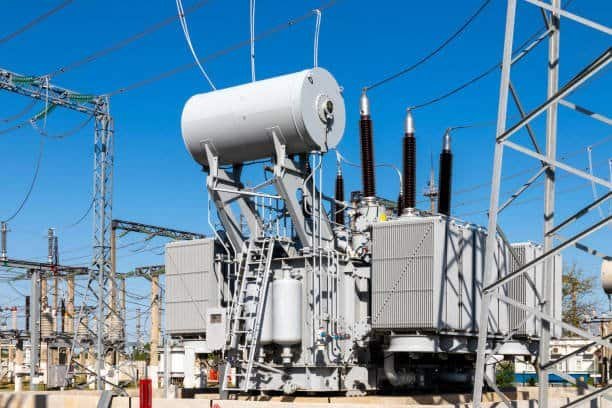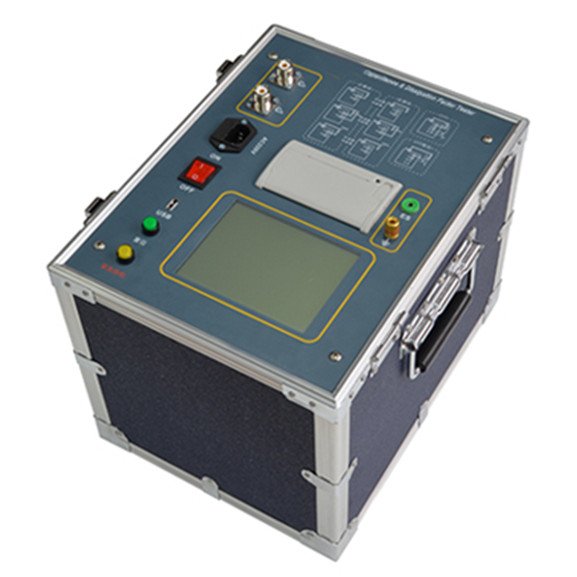What is tan- delta testing ?
Tan delta testing, also known as dissipation factor (PF) testing, or loss angle testing or dielectric dissipation factor(DDF) , is a diagnostic method used to measure dielectric loss/dissipation factor(tgδ) and capacitance (Cx) and evaluate the insulation condition of electrical equipment, such as cables, transformers, capacitors, and rotating machines.

The purpose of dielectric loss test is to supervise the quality of process treatment and manufacturing quality in the production process of transformer. The test can indirectly identify the reliability of transformer insulation under the action of high voltage.
It also can verify the good or bad vacuum treatment of the transformer and the influence of moisture ,aging and dirt, in order to find out the local defects of transformer insulation in time.
The dielectric loss test is customarily referred to as the characteristic of insulation test.
Principle of tan delta testing
The power P consumed by the insulating medium under the influence of AC voltage is the dielectric loss (Fig. 1). However, P varies with the change in the voltage U, it is a variable.
To effectively illustrate dielectric loss, we use the dielectric loss factor tanδ. The origin of δlies in the factor that the insulating medium experiences not only active power loss P, but also reactive power loss Q.
This causes the power factor angle φbetween the applied AC voltage and the current to be less than 90°.δ is the residual angle of the power factor angle (Figure 2). tanδ can be expressed as






Once the transformer state is determined, whether in the series model or shunt model the equivalent resistance and capacitance of the transformer is also determined, and thus the tanδ of the test combination is also determined for a certain value.
Therefore, it is considered that tanδ is inherent in a certain state of the insulating material, which can be used as a basis for judging whether the insulation state of the product is good or not, and is one of the basic characteristics of the insulating medium.
Is tan Delta testing destructive?
Tan Delta testing is a non-destructive diagnostic method used to assess the condition of insulation in transformers and other electrical equipment. This testing evaluates the dielectric properties of insulation materials, helping to identify potential issues without causing damage.
Non-Destructive Nature
Tan Delta testing is designed to be non-destructive, meaning it does not physically harm the transformer or its insulation. It measures the dissipation factor, which indicates the quality of the insulation and helps detect issues like moisture or contamination without altering the equipment’s integrity.
Assessment of Insulation Condition
By measuring the tan delta value, operators can determine the level of deterioration in the insulation. High tan delta values can indicate problems such as aging, moisture ingress, or contamination, prompting further investigation or maintenance actions.
Comparative Analysis
The results from Tan Delta testing can be compared over time, allowing for the monitoring of insulation condition and the identification of trends that may indicate worsening conditions. This helps in planning maintenance and replacement strategies effectively.
Sensitivity to Insulation Issues
The test is sensitive to changes in insulation quality, making it effective for detecting issues early. This proactive approach can prevent more serious failures and extend the lifespan of the transformer
What is the difference between tan delta test and megger test?
Transformer Dielectric Loss Test and Transformer Insulation Resistance Test are two different electrical test methods. Here is an explanation of the differences between two different electrical test methods on the purpose , principle and simple operation steps.
Purpose
Insulation resistance test is mainly used to assess the insulation performance of transformer windings and its parts to ground or each other. By measuring the insulation resistance value, it can be judged whether the insulation material is damp, aging or there are problems such as partial discharge.
Dielectric loss test (tanδ test): It is used to evaluate the overall insulation status of the transformer, especially the capacitance and leakage current of the windings. The dielectric loss value reflects the degree of loss of insulation material, usually used to detect insulation deterioration and partial discharge phenomenon.
Principle
Insulation Resistance Test: The insulation resistance value is calculated by applying a DC voltage (e.g. 500V) and measuring the leakage current within a certain period of time (usually 1 minute). The larger the insulation resistance value, the better the insulation performance.
Dielectric loss test: By applying industrial frequency AC voltage (e.g. 10kV), measure the leakage current between the transformer windings or the leakage current of the windings to the ground, so as to calculate the dielectric loss value. Dielectric loss value is an important parameter reflecting the quality of insulation, under normal circumstances the dielectric loss value should be low.
Operation steps
Insulation resistance test: connect the megohmmeter to the transformer between the energized part and the shell, apply a DC voltage of about 500V, and read the insulation resistance value after applying the voltage for 1 minute. For transformers with high voltage ratings, it may be necessary to use a higher voltage megohmmeter (e.g. 5000V).
Dielectric loss test: After shorting the windings under test to ground and fully discharging them, apply an appropriate AC voltage (e.g. 10kV) and measure the leakage current. The test is usually carried out at different temperatures and the tanδ values at different temperatures are converted according to the formula.
The advantage of Transformer tan delta test VS megger test
Compared with transformer insulation resistance testing , Transformer dielectric loss testing has the following advantages over transformer insulation resistance testing:
Higher sensitivity:
Dielectric loss testing can more effectively detect the overall insulation condition of the transformer, especially those small defects and insulation deterioration. For example, it can reflect the energy loss of the insulation medium under the action of AC electric field, thus providing more detailed information on the insulation condition.
Unaffected by test voltage, specimen size and other factors
the dielectric loss value has nothing to do with the test voltage, specimen size and so on, which makes the dielectric loss test results more stable and reliable, and facilitates the judgment of the change of the insulation of electrical equipment.
High degree of automation
Dielectric loss test can be computer-assisted data analysis, sampling and analysis of transformer current and voltage waveforms, and then get the value of dielectric loss. This process is simple and can be automated, convenient and quick.
Detect the insulation resistance test is difficult to find the problem
Dielectric loss test can detect some insulation resistance test can not find the problem, such as partial discharge, capacitance changes and insulation aging. These problems are quantified and diagnosed by measuring the dielectric loss factor.
Specifically, transformer tangent delta test can detect the following problems:
Partial discharges: Since the dielectric loss test is based on the detection of equipment discharges, the phenomenon of partial discharges can be effectively detected.
Capacitance changes: Dielectric loss testing evaluates the insulation condition of transformers and bushings by measuring capacitance and dielectric loss factor, which can help detect capacitance changes.
Insulation Aging: Insulation materials age over time, resulting in an increase in dielectric loss values. Such changes can be detected and dealt with in time through dielectric loss testing.
Transformer insulation resistance test is limited in sensitivity and detection range, although it can also detect dampness in the transformer insulation as a whole, dampness or dirt on the exterior of the components, and penetrating and concentrated defects (e.g., ruptured insulators, leads against the shell, etc.).
Therefore, the combined use of dielectric loss testing and insulation resistance testing provides a more comprehensive assessment of the insulation condition of a transformer to ensure its safe and reliable operation.
Transformer Tan Delta Tester

Transformer tan delta tester has a wide range of applications in the power industry and is mainly used to measure the dielectric loss tangent (tanδ) and capacitance (Cx) of high voltage power equipment such as transformers, CT transformers, bushings, capacitors, and surge arresters. These parameters are essential for assessing the insulation performance of the equipment.
The Application cope of transformer tan delta tester is used in power plants and substations on-site or in the laboratory for high-precision testing of dielectric loss tangent and capacitance of various high-voltage power equipment such as transformer insulating bushings, cables, overhead lines and other high-voltage equipment.
Features of transformer tan delta KV-6000A
- Integrated with a dielectric loss bridge, a frequency conversion power supply, a testing transformer, and an SF6 high stability standard capacitor.
- Digital notch technology is used to eliminate interference from the power frequency electric field.
- The high-voltage source is produced internally by an inverter and is stepped up by the transformer before being applied to the test object.
- Offers multiple protections against input voltage fluctuations, output short circuits, over-voltage, over-current, and temperature, ensuring safety and reliability. It also includes a ground testing feature, preventing voltage boosting in non-grounded equipment.
- Features an LCD touch screen with an easy-to-navigate English menu.
- Capable of storing up to 200 groups of data, organizing test results chronologically for easy access and printing.
- Versatile testing modes include internal high voltage, external high voltage, internal standard, external standard, GST/UST, and self-excitation. High voltage (above 12kV) dielectric loss tests can be conducted using the external standard and external high voltage setting.
- Allows for simultaneous testing of the dielectric loss and capacitance of both C1 and C2 in fully sealed CVTs (Capacitive Voltage Transformers), as well as assessing the CVT transformation ratio and voltage angle difference.
- Can accurately measure the CVT dielectric loss and capacitance values without detaching the CVT high voltage lead.
- Employs the reverse shielding method to measure the dielectric loss and capacitance value of C0 at the upper end of the CVT.
- Incorporates high-speed signal sampling, with a digitally controlled inverter and sampling circuit. The output voltage is continuously adjustable.
Transformer tan delta tester is a critical diagnostic tool for assessing the insulation condition in transformers.
1. Insulation Condition Assessment
Tan delta testing is primarily used to evaluate the quality of transformer insulation. By measuring the dissipation factor (tan δ), it helps identify potential insulation weaknesses, defects, or deterioration due to aging, moisture ingress, or contamination.
2.Diagnostic Testing
The test allows for the monitoring of insulation health over time. By comparing tan delta values from successive tests, technicians can detect gradual deterioration and schedule timely maintenance or repairs, thus preventing unexpected failures.
3.Quality Control During Manufacturing
Tan delta testing is often performed during the manufacturing of transformers to ensure the integrity and quality of the insulation system. This helps in identifying any issues before the transformer is put into service.
4.Evaluation of Transformer Components
The testing can be applied to various components of the transformer, including windings, bushings, and cables. It helps in assessing the insulation condition of these components, providing insights into their operational reliability
5.Trend Analysis for Predictive Maintenance
Regular tan delta testing facilitates trend analysis, allowing operators to track changes in insulation condition over time. This predictive maintenance approach helps in planning interventions before serious problems arise, thereby enhancing the reliability of transformer operations.
6.Compliance with Standards
Tan delta testing helps ensure compliance with industry standards (like IEC and IEEE) for transformer insulation. Results can be compared against specified thresholds to determine if the insulation is within acceptable limits, thus supporting regulatory compliance and safety.
Transformer tan delta tester is not only can effectively assess the insulation status of the equipment, but also provide a scientific basis for maintenance and overhaul. Its high precision, strong anti-interference ability and easy operation make it an indispensable testing tool in the power industry.





